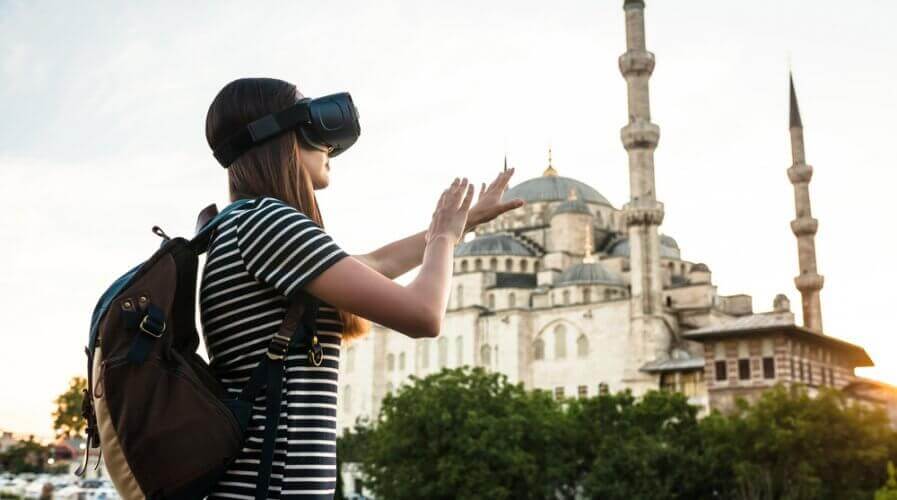
These technologies are “the new black” for travel-related companies and brands. Source: Shutterstock.
Which technologies are helping companies transform the travel industry?
WE LIVE in a time when tourist numbers around the world are rising, people are more connected and becoming global citizens, and the travel industry is burgeoning.
Coupled with old technologies that have begun evolving at a rapid speed and new technologies that are being introduced every single day and are subscribed to by approving users, travel and hospitality-related companies can either jump on the bandwagon or fall behind.
According to Expedia’s 2018 Travel Tech Trends and Industry Opportunities report, new technologies are seeing swift uptake from consumers, driven by consumers’ growing digital impatience and expectation for instant responses, answers and solutions to their queries and purchasing requests.
For travel and hospitality-related companies, change is imminent, and they see the need to use new technologies to improve operational efficiencies, meets customers’ expectations, and of course, engage with consumers better.
Here are some technologies that are transforming the travel industry and the companies that use them:
Artificial intelligence (AI)
AI makes it possible for machines to learn from experience, adjust to new inputs, mimic human behavior and complete tasks.
This can be found in some of the simplest, daily things such as Chatbots, which are offshoots of AI.

Some companies have even gone the extra mile to name their Chatbots, thus “humanizing” the programs. Source: Shutterstock.
For example, companies are implementing Chatbot systems on their websites to help relieve the load on its hotlines. With Chatbots, time-starved (or impatient) travelers can get their queries across and expect a quicker response than, say, sending through an e-mail.
Some travelers even prefer Chatbots over travel agents when planning their vacation, with up to 55% of millennials saying that interacting with a Chatbot has changed their perception of a business positively.
Companies that use it:
- Air New Zealand (named Oscar)
- AirAsia
- Finnair (named Finn)
- Expedia
- Allora (named Dorothy)
- Skyscanner
- FCM Travel Solutions (named Sam)
- 30SecondsToFly (named Claire)
Chatbots are also a fuss-free way to have all queries and important information saved in a single conversation flow in the conversation history, so a user will always have it at their fingertips.
Voice technology
Talking to technology and making it do things for us all started with Apple’s virtual assistant, Siri.
First introduced when she was integrated into the iPhone 4S in October 2011, the relatively small voice back then wowed techies from around the world and exploded into mainstream success.

The voice that changed technology. Source: Shutterstock.
Siri was responsible for turning voice technology into an entire industry, with other companies picking it up, such as Amazon (with Alexa) and Google (with Google Home and the Android OS).
For travelers, voice technology is a much more powerful interface and easier to use especially while on the go. Voice-enabled devices take the pain of typing in search keywords and clicking through multiple drop-down menus and links before getting the desired result.
A recent Travelport research has found that 72 percent of Chinese travelers use voice search compared to just 33 percent in the UK.
One of the first travel companies to drown out everyone else was metasearch engine Skyscanner, which created a hotel search bot on the Telegram messaging service that understood some natural language input.
Hotels, too, are getting their share of the voice technology pie. “For hotels, Marriott, IHG, Best Western, and Kimpton are among the pioneers in the sector. Principally these brands are looking at using speakers in guests’ rooms to provide services and ease guest requests,” hospitalitynet wrote.
Augmented and virtual reality
From PokemonGO to travel promotional materials, augmented reality (AR) and virtual reality (VR) technologies are “the new black.” Techies and consumers love it for its warped sense of perception, of being present in place fictional or non-fictional without actually being there.
It’s well on its way to becoming a mainstream consumer product, and it’s easy to see (no pun intended) why it’s a perfect fit for the travel and tourism industries.

A “reality” that you can choose. What will be yours? Source: Shutterstock.
In February this year, Japanese tour firm First Airlines rolled out a one-of-a-kind service that allows passengers to virtually visit destinations in a short two-hour “flight,” that would otherwise take upwards of 10 hours.
Passengers just needed to be strapped into a simulator to enjoy “traveling” to their destination in the comfort of first and business class cabins. The experience included everything that one would experience on an actual flight such as a safety announcement by the cabin crew and a four-course fine-dining in-flight meal.
Upon “arrival,” travelers will then be given high-tech virtual reality headsets to put on to explore their destination’s sites.

Staff dressed as flight attendants perform a safety demonstration at the First Airlines virtual first-class airline experience facility in Tokyo, Japan. Source: Reuters/Toru Hanai
Other travel companies, such as Thomas Cook, Flight Centre, and Virgin Holidays are also using VR in-store to promote destinations they’re selling by giving immersive tours.
Renowned multinational hospitality company Shangri-La Hotels was perhaps the first if not one of the first hotel group to use VR across all its global sales offices to promote its properties worldwide.
Even the aforementioned Niantic-developed PokemonGO was used by tourism authorities worldwide to promote their destinations.
Case in point, when Japan used the app to boost tourism in its disaster-struck regions, such as earthquake-struck Fukushima.

In 2016, PokemonGO unleashed an army of Lapras, a rare Pokemon, in select areas to boost tourism. Source: Pokemon GO Japan.
Translation: We have confirmed that the frequency to encounter Lapras has been increased in the coastal area of Iwate, Miyagi, and Fukushima prefecture. Apparently, it will continue until 23 Nov. It’s time to travel there where you can experience Tohoku district! We believe that you can find a lot of awesome things besides PokemonGO.
Blockchain
According to industry experts, emerging technology blockchain is the next major disruptor to the travel industry. And by the looks of how quickly companies are adopting cryptocurrencies, that seems to be true.
In February this year, Brisbane Airport, one of Australia’s biggest airports, announced it struck a game-changing deal with cryptocurrency travel firm TravelbyBit. The airport will become the world’s first airport to accept Bitcoin and other cryptocurrencies as a legitimate currency.
Brisbane Airport and TravelbyBit launch world-first digital currency airport terminal https://t.co/J2ImE3qyxm pic.twitter.com/9x9ro3Kuds
— Brisbane Airport ✈️ (@BrisbaneAirport) January 23, 2018
Upon the announcement, Brisbane Airport Corporation (BAC) General Manager Strategic Planning and Development Roel Hellemons said, “Many people around the world have made money investing in cryptocurrencies, and a lot of these people travel internationally, so it makes sense to offer a digital currency experience within our terminals.”
He also added that it was “just the beginning” for them as they hope to expand the digital currency option across the business.
Southeast Asian travel firm Smiling Albino has also started acknowledging Bitcoin installments for all treks to Thailand, Cambodia, Vietnam, Laos, and Myanmar. The organization said it was “a more productive approach to pay for an excursion.”

Bitcoin ATMs near the Wan Chai MTR station in Hong Kong. Source: Shutterstock.
All Nippon Airways (ANA) low-cost airline Peach Aviation has big plans to install and operate Bitcoin ATMs in different airplane terminals in Japan. It was also the country’s first carrier to enable transactions using bitcoin.
And soon, Singapore Airlines will launch a digital wallet for its frequent flyer KrisFlyer programme that will be powered by a private blockchain.
A world’s first, but certainly won’t be the last.
This story was first published on Travel Wire Asia by Lainey Loh.
READ MORE
- Ethical AI: The renewed importance of safeguarding data and customer privacy in Generative AI applications
- How Japan balances AI-driven opportunities with cybersecurity needs
- Deploying SASE: Benchmarking your approach
- Insurance everywhere all at once: the digital transformation of the APAC insurance industry
- Google parent Alphabet eyes HubSpot: A potential acquisition shaping the future of CRM




